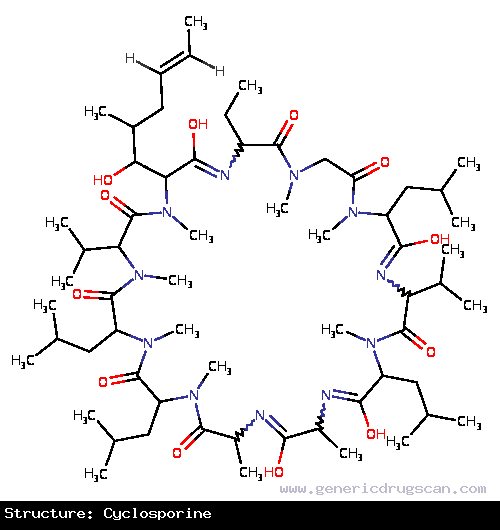Cyclosporine Drug: Indication, Dosage, Precaution, Side Effect , Storage, Category Type and corresponding Brands - www.genericdrugscan.com
Cyclosporine
Drug Status in USA : ApprovedDrug Status in Canada : Approved
pronunciation
pronounced as (sye' kloe spor een)
Why is this medication prescribed?
Cyclosporine and cyclosporine (modified) are used with other medications to prevent transplant rejection (attack of the transplanted organ by the immune system of the person who received the organ) in people who have received kidney, liver, and heart transplants. Cyclosporine (modified) is also used alone or with methotrexate (Rheumatrex) to treat the symptoms of rheumatoid arthritis (arthritis caused by swelling of the lining of the joints) in patients whose symptoms were not relieved by methotrexate alone. Cyclosporine (modified) is also used to treat psoriasis (a skin disease in which red, scaly patches form on some areas of the body) in certain patients who have not been helped by other treatments. Cyclosporine and cyclosporine (modified) are in a class of medications called immunosuppressants. They work by decreasing the activity of the immune system.
How should this medicine be used?
Cyclosporine and cyclosporine (modified) both come as a capsule and a solution (liquid) to take by mouth. Cyclosporine is usually taken once a day. Cyclosporine (modified) is usually taken twice a day. It is important to take both types of cyclosporine on a regular schedule. Take cyclosporine or cyclosporine (modified) at the same time(s) each day, and allow the same amount of time between doses and meals every day. Follow the directions on your prescription label carefully, and ask your doctor or pharmacist to explain any part you do not understand. Take cyclosporine or cyclosporine (modified) exactly as directed. Do not take more or less of the medication or take it more often than prescribed by your doctor.
Your doctor will probably adjust your dose of cyclosporine or cyclosporine (modified) during your treatment. If you are taking either type of cyclosporine to prevent transplant rejection, your doctor will probably start you on a high dose of the medication and gradually decrease your dose. If you are taking cyclosporine (modified) to treat rheumatoid arthritis or psoriasis, your doctor will probably start you on a low dose of the medication and gradually increase your dose. Your doctor may also decrease your dose if you experience side effects of the medication. Tell your doctor how you are feeling during your treatment.
Cyclosporine (modified) helps control the symptoms of psoriasis and rheumatoid arthritis, but does not cure these conditions. If you are taking cyclosporine (modified) to treat psoriasis, it may take 2 weeks or longer for your symptoms to begin to improve, and 12 to 16 weeks for you to feel the full benefit of the medication. If you are taking cyclosporine (modified) to treat rheumatoid arthritis, it may take 4 to 8 weeks for your symptoms to improve. Continue to take cyclosporine (modified) even if you feel well. Do not stop taking cyclosporine (modified) without talking to your doctor. Your doctor may decrease your dose gradually.
You may notice an unusual smell when you open a blister card of cyclosporine capsules. This is normal and does not mean that the medication is damaged or unsafe to use.
Cyclosporine (modified) oral solution may gel or become lumpy if it is exposed to temperatures below 68 ?F (20 ?C). You can use the solution even if it has gelled, or you can turn the solution back to a liquid by allowing it to warm to room temperature (77 ?F
- 25 ?C
Cyclosporine and cyclosporine (modified) oral solution must be mixed with a liquid before use. Cyclosporine (modified) oral solution may be mixed with orange juice or apple juice but should not be mixed with milk. Cyclosporine oral solution may be mixed with milk, chocolate milk, or orange juice. You should choose one drink from the appropriate list and always mix your medication with that drink.
To take either type of oral solution, follow these steps:- Fill a glass (not plastic) cup with the drink you have chosen.
- Remove the protective cover from the top of the dosing syringe that came with your medication.
- Place the tip of the syringe into the bottle of solution and pull back on the plunger to fill the syringe with the amount of solution your doctor has prescribed.
- Hold the syringe over the liquid in your glass and press down on the plunger to place the medication in the glass.
- Stir the mixture well.
- Drink all of the liquid in the glass right away.
- Pour a little more of the drink you have chosen into the glass, swirl the glass around to rinse, and drink the liquid.
- Dry the outside of the syringe with a clean towel and replace the protective cover. Do not wash the syringe with water. If you do need to wash the syringe, be sure that it is completely dry before you use it to measure another dose.
What are the precautions to be followed?
Before taking cyclosporine or cyclosporine (modified),- tell your doctor and pharmacist if you are allergic to cyclosporine, cyclosporine (modified), any other medications, or any of the inactive ingredients in cyclosporine or cyclosporine (modified) capsules or solution. Ask your pharmacist for a list of the inactive ingredients.
- tell your doctor and pharmacist what prescription and nonprescription medications, vitamins, and nutritional supplements you are taking, or plan to take. Be sure to mention the medications listed in the IMPORTANT WARNING section and any of the following: acyclovir (Zovirax); allopurinol (Zyloprim); amiodarone (Cordarone); angiotensin-converting enzyme (ACE) inhibitors such as benazepril (Lotensin), captopril (Capoten), enalapril (Vasotec), fosinopril (Monopril), lisinopril (Prinivil, Zestril), moexipril (Univasc), perindopril (Aceon), quinapril (Accupril), ramipril (Altace), and trandolapril (Mavik); angiotensin II receptor antagonists such as candesartan (Atacand), eprosartan (Teveten), irbesartan (Avapro), losartan (Cozaar), olmesartan (Benicar), telmisartan (Micardis), and valsartan (Diovan); certain antifungal medications such as fluconazole (Diflucan), and itraconazole (Sporanox); azithromycin (Zithromax); bromocriptine (Parlodel); calcium channel blockers such as diltiazem (Cardizem), nicardipine (Cardene), and verapamil (Calan); carbamazepine (Tegretol); cholesterol-lowering medications (statins) such as atorvastatin (Lipitor), fluvastatin (Lescol), lovastatin (Mevacor), pravastatin (Pravachol), and simvastatin (Zocor); clarithromycin (Biaxin); dalfopristin and quinupristin combination (Synercid); danazol; digoxin (Lanoxin); certain diuretics ('water pills') including amiloride (Midamor), spironolactone (Aldactone), and triamterene (Dyazide); erythromycin; HIV protease inhibitors such as indinavir (Crixivan), nelfinavir (Viracept), ritonavir (Norvir, in Kaletra), and saquinavir (Fortovase); imatinib (Gleevec); metoclopramide (Reglan); methylprednisolone (Medrol); nafcillin; octreotide (Sandostatin); oral contraceptives (birth control pills); orlistat (Xenical); phenobarbital; phenytoin (Dilantin); potassium supplements; prednisolone (Pediapred); repaglinide (Prandin); rifabutin (Mycobutin); rifampin (Rifadin, Rimactane); sulfinpyrazone (Anturane); terbinafine (Lamisil); and ticlopidine (Ticlid). Your doctor may need to change the doses of your medications or monitor you more carefully for side effects.
- if you are taking sirolimus (Rapamune), take it 4 hours after you take cyclosporine or cyclosporine (modified).
- tell your doctor what herbal products you are taking, especially St. John's wort.
- tell your doctor if you have or have ever had any of the conditions mentioned in the IMPORTANT WARNING section or any of the following: low cholesterol, low levels of magnesium in your blood, any condition that makes it difficult for your body to absorb nutrients, or liver disease.
- tell your doctor if you are pregnant or plan to become pregnant. If you become pregnant while taking either type of cyclosporine, call your doctor. Both types of cyclosporine may increase the risk that your baby will be born too early.
- tell your doctor if you are breast-feeding or planning to breast-feed.
- do not have vaccinations without talking to your doctor.
- you should know that cyclosporine may cause growth of extra tissue in your gums. Be sure to brush your teeth carefully and see a dentist regularly during your treatment to decrease the risk that you will develop this side effect.
What are possible side effects of this medication ?
Cyclosporine and cyclosporine (modified) may cause side effects. Tell your doctor if any of these symptoms are severe or do not go away:- headache
- diarrhea
- heartburn
- gas
- increased hair growth on the face, arms, or back
- growth of extra tissue on the gums
- acne
- flushing
- uncontrollable shaking of a part of your body
- burning or tingling in the hands, arms, feet, or legs
- muscle or joint pain
- cramps
- pain or pressure in the face
- ear problems
- breast enlargement in men
- depression
- difficulty falling asleep or staying asleep
- unusual bleeding or bruising
- pale skin
- yellowing of the skin or eyes
- seizures
- loss of consciousness
- changes in behavior or mood
- difficulty controlling body movements
- changes in vision
- confusion
- rash
- purple blotches on the skin
- swelling of the hands, arms, feet, ankles, or lower legs
Cyclosporine and cyclosporine (modified) may cause other side effects. Talk to your doctor if you experience unusual problems while taking either medication.
How to store the medication and dispose it of after its use later?
Keep this medication in the container it came in, tightly closed and out of reach of children. Store it at room temperature and away from excess heat and moisture (not in the bathroom). Do not store this medicine in the refrigerator and do not freeze it. Dispose of any remaining solution 2 months after you first open the bottle.
Unneeded medications should be disposed of in special ways to ensure that pets, children, and other people cannot consume them. However, you should not flush this medication down the toilet. Instead, the best way to dispose of your medication is through a medicine take-back program.
Drug Category/Class
- Antirheumatic Agents
- Dermatologic Agents
- Antifungal Agents
- Enzyme Inhibitors
- Calcineurin Inhibitors
- Cytochrome P-450 CYP2C9 Inhibitors
- Cytochrome P-450 CYP2C9 Inducers
- Cytochrome P-450 CYP2C19 Inducers
- CYP2D6 Inducers
- CYP2D6 Inducers (strong)
- BSEP
- ABCB11 Inhibitors
- Combined Inhibitors of CYP3A4 and P-glycoprotein
- Ophthalmologicals
- Sensory Organs
- Cytochrome P-450 CYP2C8
| Prescribed | For treatment of transplant (kidney, liver, and heart) rejection, rheumatoid arthritis, severe psoriasis. |
| Weight : | 1202.6112 |
| Structure | Cyclosporine |
 | |
| Formula | C62H111N11O12 |
Cyclosporine has 37 Brands listed
Search Generic Drugs alphabetically
